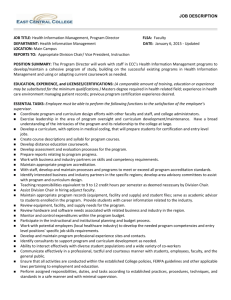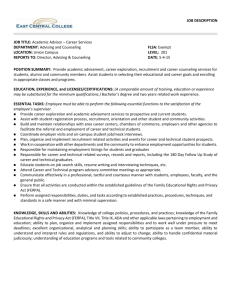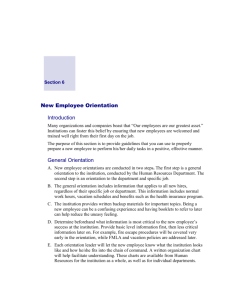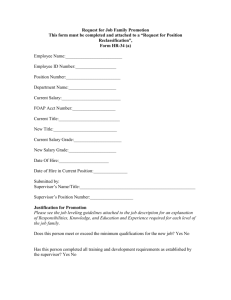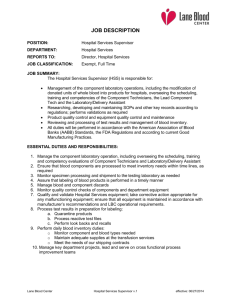UCOP Career Tracks Frequently Asked Questions (FAQs)
advertisement
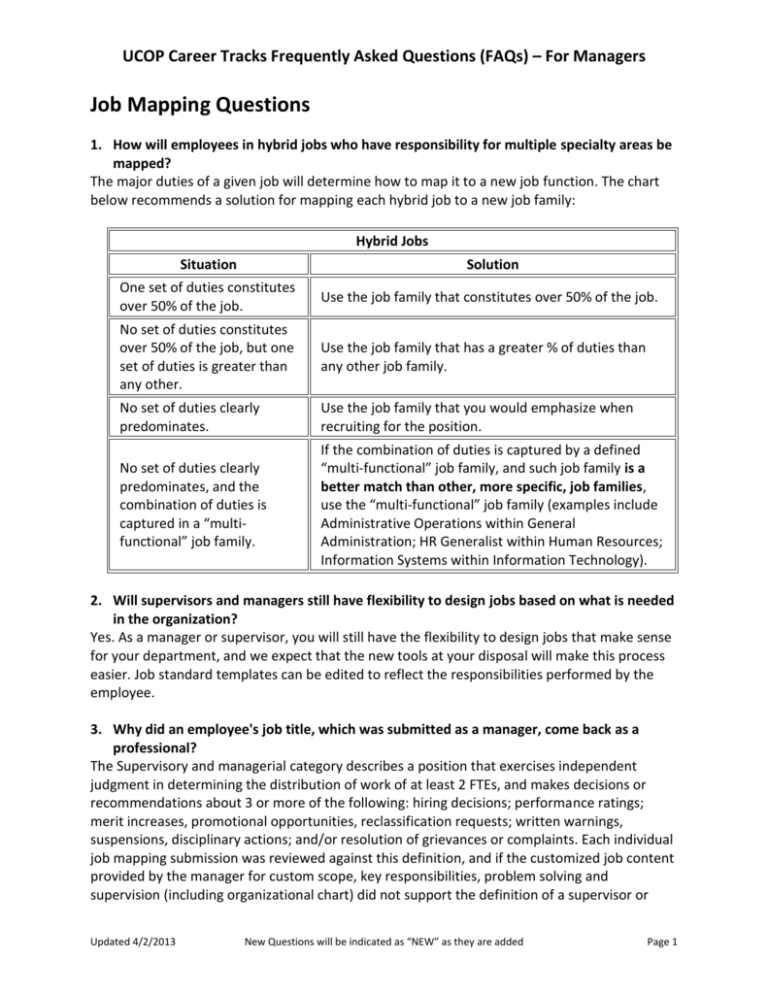
UCOP Career Tracks Frequently Asked Questions (FAQs) – For Managers Job Mapping Questions 1. How will employees in hybrid jobs who have responsibility for multiple specialty areas be mapped? The major duties of a given job will determine how to map it to a new job function. The chart below recommends a solution for mapping each hybrid job to a new job family: Hybrid Jobs Situation Solution One set of duties constitutes over 50% of the job. Use the job family that constitutes over 50% of the job. No set of duties constitutes over 50% of the job, but one set of duties is greater than any other. Use the job family that has a greater % of duties than any other job family. No set of duties clearly predominates. Use the job family that you would emphasize when recruiting for the position. No set of duties clearly predominates, and the combination of duties is captured in a “multifunctional” job family. If the combination of duties is captured by a defined “multi-functional” job family, and such job family is a better match than other, more specific, job families, use the “multi-functional” job family (examples include Administrative Operations within General Administration; HR Generalist within Human Resources; Information Systems within Information Technology). 2. Will supervisors and managers still have flexibility to design jobs based on what is needed in the organization? Yes. As a manager or supervisor, you will still have the flexibility to design jobs that make sense for your department, and we expect that the new tools at your disposal will make this process easier. Job standard templates can be edited to reflect the responsibilities performed by the employee. 3. Why did an employee's job title, which was submitted as a manager, come back as a professional? The Supervisory and managerial category describes a position that exercises independent judgment in determining the distribution of work of at least 2 FTEs, and makes decisions or recommendations about 3 or more of the following: hiring decisions; performance ratings; merit increases, promotional opportunities, reclassification requests; written warnings, suspensions, disciplinary actions; and/or resolution of grievances or complaints. Each individual job mapping submission was reviewed against this definition, and if the customized job content provided by the manager for custom scope, key responsibilities, problem solving and supervision (including organizational chart) did not support the definition of a supervisor or Updated 4/2/2013 New Questions will be indicated as “NEW” as they are added Page 1 UCOP Career Tracks Frequently Asked Questions (FAQs) – For Managers manager job standard, the employee was subsequently approved for a professional job title. Professionals may achieve and be responsible for many of the same functional responsibilities as a manager or supervisor, but achieve results through their own, personally performed duties, rather than through the efforts of direct reports. 4. It seems that manager and supervisor job standards undervalue scope and influence of the position and focus too much on supervision of staff. A key objective of new job standards is to be able to differentiate jobs based on primary focus of the position so that they could be more easily compared to external jobs in the labor market. 5. What's the difference between a supervisor and a manager? Specific differences are described by the generic scope of each supervisory and managerial level. Another way to look at it is that a manager is responsible for making significant decisions on what the unit does: its purpose, functions and role, and for making commitments and decisions that require the expenditure of significant unit resources. Managers have a significant, external focus (to the world outside the unit), whereas a supervisor has a more internal focused responsibility for implementing the manager's decisions through the work of subordinate employees. Once a decision is made on what to do, supervisors have a significant role in deciding how to do it; how to achieve the objective established by the manager. Supervisors often perform the same kind of work that the subordinates do; managers do not do the daily work of the unit as a regular part of their work, they may do it more on an exception basis or in resolving the most difficult problems facing the unit. 6. What's the difference between a Supervisory Level 2 (S2) and Supervisory Level 1 (S1)? The key differences between S2 and S1 are defined by the generic scope. A S1 provides immediate supervision to a unit or group of operational or technical employees, whereas a S2 provides supervision and guidance to a group of professionals or skilled operational and technical employees. 7. A position was mapped to a Manager Level 1 (M1) instead of a Manager Level 2 (M2). Why? The Compensation Unit, HR and executives reviewed all levels of manager job mapping across all departments at OP to ensure that individual positions were aligned consistently across departments and job families by starting with the generic scope for each job description under review. For example, positions mapped to a M2 have responsibility for managing a department though subordinate managers. In contrast, a M1 is the primary manager of a unit or department and does not manage subordinate managers. This is a difficult concept to apply consistently given the lack of hierarchy in many departments, and great care was taken to ensure that employees were not unfairly disadvantaged based on department structure. The M2 job typically oversees one or more managers or multiple supervisors and professionals. The review process also consistently applied other components of generic scope – M2 positions also serve as a consultant to senior management, and have significant responsibility to achieve Updated 4/2/2013 New Questions will be indicated as “NEW” as they are added Page 2 UCOP Career Tracks Frequently Asked Questions (FAQs) – For Managers broadly stated goals for the department, identify objectives, direct programs, and develop overall departmental or organizational strategies and policies. 8. A position was mapped to a Manager Level 2 (M2) instead of a Manager Level 3 (M3). Why? The Compensation Unit, HR and executives reviewed all levels of manager job mapping across all departments at OP to ensure that individual positions were aligned consistently across departments and job families by starting with the generic scope for each job description under review. For example, positions mapped to a M3 lead a critical function, typically managing multiple subordinate organizations with different levels of Managers 1 and 2, supervisors, professionals and other staff. In contrast, a M2 has responsibility for managing a department though subordinate managers, supervisors and professionals, serves as a consultant to senior management, has significant responsibility to achieve broadly stated goals for the department, identifies objectives, directs programs, and develops overall departmental strategies and policies. 9. A position was mapped to a Manager Level 3 (M3) instead of a Manager Level 4 (M4). Why? The Compensation Unit, HR and executives reviewed all levels of manager job mapping to ensure that individual positions were aligned consistently across departments and job families by applying the generic scope to each job description under review. For example, positions mapped to a M4 serve as the senior manager overseeing a large organization with multiple departments. They identify objectives and direct critical programs with major constituencies across the organization. Very few positions meet the M4 criteria. In contrast, a M3 position leads a critical function, typically managing multiple subordinate organizations with different levels of Managers 1 and 2, supervisors, professionals and other staff. Other HR Practices 10. Once we implement Career Tracks, how do we use the new job standards to fill an open position? For a vacant position, the supervisor will prepare a job description based on the Career Tracks job standards. The supervisor will work with HR to select the appropriate Career Tracks job standard from the Classification/Applicant Tracking System (CATS). If the supervisor does not have access to the CATS system, he or she can also retrieve job standards from SharePoint or ask HR for assistance. The supervisor will need to customize the job standard as necessary to reflect the responsibilities of the open position and get the position entered into CATS. 11. How will reclassifications happen in the new system? Supervisors and managers will be asked to submit reclassification requests using the new Career Tracks job standards in the Classification/Applicant Tracking System (CATS) if significant and permanent job duties have changed. The supervisor will work with HR to select the appropriate Career Tracks job standard from CATS. If the supervisor does not have access to Updated 4/2/2013 New Questions will be indicated as “NEW” as they are added Page 3 UCOP Career Tracks Frequently Asked Questions (FAQs) – For Managers CATS, he or she can also retrieve job standards from SharePoint or ask HR for assistance. The supervisor will need to customize the job standard as necessary to reflect the responsibilities of the position and get the position entered into CATS. Once a revised position description has been entered into CATS, the system will automatically generate a reclassification request from Compensation. Compensation will review and assign a grade and range in the new Career structure. 12. Will the job description be easier to complete once we convert to Career Tracks? Yes, pre-filled job description forms will be available for customization in the Classification/Applicant Tracking System (CATS) and on SharePoint, based on job standards that have been developed for each job title. We expect over 50% of the work will already be completed for managers and supervisors when they use the job standard as the basis for a customized description, based on the Job Family, Function, Category and Career Level. This should significantly reduce the effort needed to provide Job Descriptions for an employee reclassification or open requisition. 13. Should managers submit mapping recommendations for open positions? Job mapping recommendations do not need to be submitted for vacant positions that are currently posted in the Classification/Applicant Tracking System (CATS). For any requisitions that become open after we implement Career Tracks, managers should use one of the Career Tracks job standards to create the job description for posting purposes. 14. How will open positions be budgeted once we transition to the Career Tracks job structure and salary ranges? The budgeting process is unchanged as a result of implementing Career Tracks. UCOP Budget would encourage you to budget for positions based on what the salary requirements will be for the job once it is filled. All new positions should be reviewed with UCOP Budget Group prior to opening up the recruitment. Updated 4/2/2013 New Questions will be indicated as “NEW” as they are added Page 4


